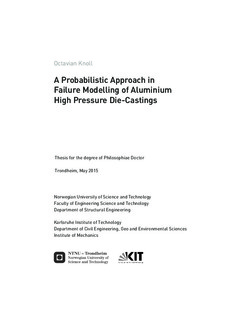| dc.description.abstract | Aluminium high pressure die-castings have become essential elements of a modern car
body in recent years. The high pressure die-casting method enables to produce thinwalled
components of complex geometries. This advantage is used to create structural
nodes and connector elements as one-piece components. These components are subjected
to extreme loads such as in crash situations and expected to maintain the structural
integrity of the car body. Numerical models are required to analyse the structural behaviour
of aluminium high pressure die-casting components and to guarantee their structural
reliability.
The material ductility in aluminium high pressure die-casting components is strongly
influenced by casting defects. Typical casting defects are shrinkage pores, gas pores and
oxide films. These casting defects are caused by the casting system and fluctuations during
the casting process. As a result, the casting defects are varying within a component.
Moreover, the variation can be separated into a global systematic variation depending on
the casting system and a local pseudo-random variation caused by the process fluctuations.
A casting defect can be considered as initial material damage which leads to a decrease
of the local material ductility. As a result, the material ductility exhibits a global systematic
variation and a local pseudo-random variation. The main objective of the present
work is the experimental and numerical analysis of these two types of variation.
The main objective of the experimental work was the investigation of the global systematic
variation and the local pseudo-random variation in the material ductility of an
aluminium HPDC alloy. Here, a generic high pressure die-casting component made of
an AlSi9Mn alloy in casting condition was considered. An extensive material characterisation
was performed using uniaxial tensile tests. The specimens were machined from
different extraction positions as well as from duplicated extraction positions of the generic
casting component. Through this sampling approach, it was possible to analyse the
systematic variation as well as the local pseudo-random variation in the material ductility.
The mechanical analysis of the tensile test results showed a reproducible strain hardening
behaviour in duplicated extraction positions, but the failure strain varied between different
extraction positions and within duplicated positions. A detailed statistical analysis was
performed on the tensile test results and hypothesis tests were applied to identify extraction
positions with comparable material ductility. Based on the results obtained from the
hypothesis tests, it was concluded that the generic casting component can be separated
into characteristic parts of comparable material ductility. Moreover, it was shown that the
local pseudo-random variation of the material ductility can be described by a weakestlink
Weibull distribution. In addition, the fracture surfaces of selected specimens were
examined by a SEM analysis and, as expected, casting defects were found on each fracture
surface and identified as the dominating factor for fracture. Besides material testing,
bending tests and axial compression testswere carried out on the generic casting component.
Especially, the experimental results obtained from the bending tests exhibited strong scatter. According to the results obtained from material testing, it was concluded that the
strong scatter is caused by the global systematic variation and the local pseudo-random
variation in the material ductility.
As a result, a probabilistic approach in failure modelling was considered in the numerical
work. Hence, it was possible to capture the local pseudo-random variation in the
material ductility. The probabilistic failure model was based on the phenomenological
Cockcroft-Latham failure criterion and the weakest-link model by Weibull. The required
quantities stress state and equivalent plastic strain were given by an isotropic hypoelasticplastic
constitutive model. The focus was put on the numerical prediction of the failure
probability of casting components. Usually, the failure probability is estimated from
a Monte-Carlo simulation based on various finite element simulations using a pseudorandomly
distributed critical failure value. In the present work, an approach was presented
to predict the failure probability from a single finite element simulation. Both approaches
were compared in numerical analysis and it was shown that both approaches
lead to the same prediction of the failure probability. The approach based on the direct
computation of the failure probability was applied in finite element simulations of the
bending test and the axial compression test of the generic casting component. According
to the material characterisation, the FE model of the generic casting component was
partitioned into three parts. For each part the parameters of the constitutive model and
the probabilistic failure modelwere found from the corresponding experimental results. It
was demonstrated that the numerically predicted failure probability and the experimentally
estimated failure probability are verywell correlated in both load cases. Consequently,
the applied probabilistic failure model was considered as validated. Moreover, a novel approach
for the pseudo-random distribution of a critical failure value was presented and
the concept of the uncoupled modelling approach was introduced. Due the uncoupled
modelling approach, it was possible to perform mesh convergence studies on finite element
models using a pseudo-randomly distributed critical failure value. However, the
probabilistic failure model captured only the local pseudo-random variation in the material
ductility. Hence, a through-process modelling approach was presented based on a
casting simulation result and the definition of casting qualities. This approach was only
numerically investigated. | nb_NO |
